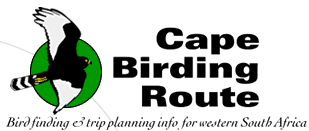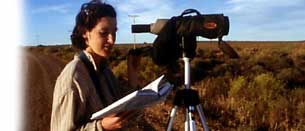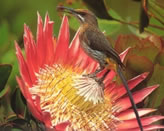|
|
| Select
Specials: Kalahari
Kori Bustard
Famed
as the heaviest flying bird in the world (although contested
by certain Mute Swans), the Kori Bustard is remarkably common
in the Kalahari Gemsbok National Park and is sure to be encountered
in the riverbeds. Early settlers of Dutch origin, whose initial
knowledge of natural history was largely based on tales of
previous European exploration in Southeast Asia, often named
African animals after these exotic beasts. Hence, leopards
were called ‘tygers’ (‘tigers’, see p.8)
and the Kori Bustard was named ‘pou’ (‘peacock’)
because of its gaudy display, when the male inflates a feathery
throat-pouch and splays its tail feathers. The Afrikaans name
Gompou (‘gum—peacock’) refers to the bird’s
curious habitat of feeding on gum oozing from the bark of
camelthorn trees. These majestic creatures also occur more
scarcely in the Augrabies Falls National Park, and indeed
throughout Bushmanland and the Kalahari.
Giant Eagle Owl
Despite
its widespread presence in Africa, this species is rarely
easy to find and will be a target of many birders visiting
the Kalahari Gemsbok National Park. The best place to look
for it is along the broad, dry bed of the Auob River, where
it roosts by day in the huge, gnarled camelthorn trees. By
driving along and scanning the trees for large silhouettes
on the heavier branches, you are bound to pick up at least
one or two on the drive from Twee Rivieren to Mata Mata. One
dead give-away is the presence, under trees, of small piles
of neatly peeled-off spiny skins of the Southern African Hedgehog
(Atelerix frontalis), which is a favoured prey item.
Burchell’s Sandgrouse
This
near-endemic can be quite elusive, and is best seen in the
Kalahari Gemsbok National Park (p.110). They are quite specific
in their habitat requirements, and are only found on the red
Kalahari sands. The best way to see them is to wait near a
waterhole, especially between 2 and 4 hours after sunrise
(p.110). Here a male is pictured soaking his absorbent, water-retaining
belly feathers, which will provide moisture for his thirsty
chicks upon his return to the nest.
Clapper Lark
This
endemic is named for its rapid wing-clapping display (conspicuous
in spring and summer) when the wings are beaten together a
remarkable 26 times per second. Although it superficially
resembles just another of Africa’s brown larks, closer
examination reveals exquisite, richly marked upperparts. The
bird pictured here is the inland grassland subspecies that
occurs in the Kalahari: the birds in the southwestern Cape
show darker brown upperparts that contrast more with the orange
underparts (see photograph on p.64). Taxonomic comments are
provided on p.13.
|
This website is maintained by Birding Africa.
Please do not use any text, images or content from this site without
permission.
© Birding Africa 1997-2009 info@capebirdingroute.org
4 Crassula Way, Pinelands, 7405, Cape Town, South Africa
|

27/09/09: Dalton
Gibbs reports back from Gough
Island! Read the blog!
26/09/09: New Cape
Town Pelagics trip report from trips of 12 and 19 September
2009.
30/08/09: British
Birdwatching Fair at Rutland Water proved very successful,
with sunny weather and over 20,000 visitors. Callan's "Birding
Namibia and the Okavango" was the most highly-attended
lecture on the Saturday, with over 240 people. Congratulations
to the winners of the Birding Africa competition and the
African Bird Club raffle that we helped sponsor!
12/08/09: New Cape
Town Pelagics trip reports from August and July 2009.
Highlights: Little
Shearwater and more!
07/08/09: The
sub-adult Black Sarrowhawk visits our garden again! Read
on about Raptor Research in the Western Cape.
27/07/09: Cape
Town's Verreauxs' Eagle Chick has grown! And its sibling
never had a chance to hatch. See the pictures of the chick,
its nest and the breeding pair. Find out more about the Western
Cape Raptor Research Programme.
27/07/09: To follow modern nomenclature and systematics, we've
adopted the IOC
World Bird List, Version 2.1.
13/07/09: The 8th
African Bird ID Challenge has launched! Win a 50% discount
on a Cape Town Pelagics
trip, a copy of Southern
African Birdfinder, or African
Bird Club membership for 1 year.
6 July 09: Cape
White-eye research in our garden.
2 July 09: Cape
Town's Verreauxs' Eagle Chick has hatched! See the pictures
of the chick, its nest and the breeding pair. Find out more
about the Western Cape Raptor Research Programme.
2 July 09: Campbell
Fleming, a Cape Town scholar, avid birder and photographer,
joined Birding Africa last month as an intern. Click here,
to see what he got up to.
2 July 09: New pelagic
trip reports from the Cape Town Pelagics trips in June
2009. Highlights: Slenderbilled
Prion and Leach's Storm Petrel
30 july 09: Our latest Cape Fynbos and Karoo trip
reports feature Hottentot
Buttonquail, Cinnamon-breasted
Warbler and other fynbos and Karoo endemics...
26 June 09: Tungsten
mining threatens RAMSAR site, South Africa's Verlorenvlei.
Read the Media Release.
22 June 09: Claire
Spottiswoode, one of the Cape Birding Route founders,
was part of the exploratory team at Mount Mabu. The mountain
is part of the newly discovered largest
rainforest in Southern Africa.
11 June 09: A colour-ringed
Black Sparrowhawk visits the Birding Africa office garden.
Read why it's a 10 months old male!
14 June 09:
Wildlife
at the office of The Cape Birding Route, Birding Africa
and Cape Town Pelagics.
31 May 09:
Michel Watelet wins the 7th African Bird Club & Birding Africa
ID Challenge. Test your African birding skills and WIN
a Birding
Africa Cape town day trip or a copy of the Birdfinder!
30 May 09:
A tragedy unfolds at Kommetjie south of Cape town as 44 beached
False
Killer Whales were shot. Click here for more details and
pictures.
14 March 09: Raptor
Watch in Cape Town on 14 March 09
|
|


